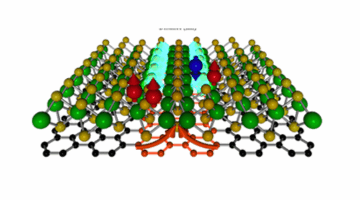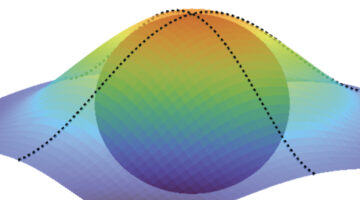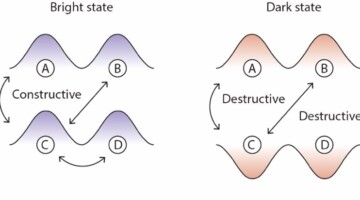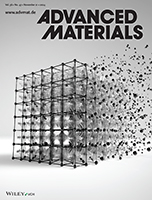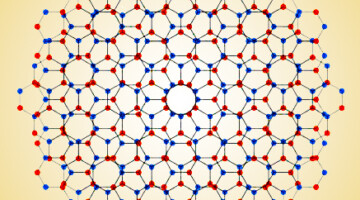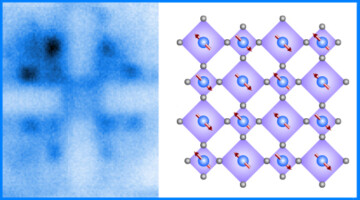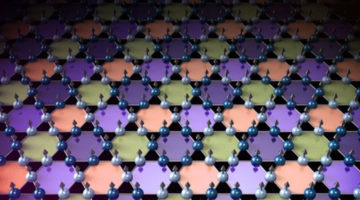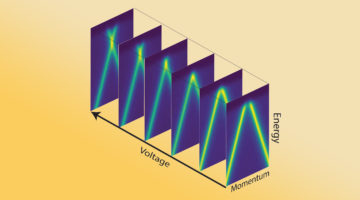Researchers are exploring how a thin film can host a Tomonaga–Luttinger liquid, which separates an electron’s charge and spin. The research findings could contribute to the development of ultra-compact and energy-efficient technologies. Read more »
A New Twist for Superconductivity in Bilayer Graphene
In a study of twisted bilayer graphene (TBG) systems, researchers found intriguing spectroscopic features in a superconducting “magic-angle” TBG—features that are absent in non-superconducting TBG. The results provide crucial information on superconductivity in magic-angle TBG for next-gen electronics and advanced energy technologies. Read more »![]()
![]()
Mapping the Quantum Landscape of Electrons in Solids
Researchers found a way to reconstruct quantum geometric tensors (QGTs)—mathematical entities that encode how an electron’s wave function is shaped by its quantum environment. The mapping of QGTs enables the discovery and control of novel quantum phenomena such as superconductivity and unconventional electronic phases. Read more »![]()
![]()
Hide-and-Seek with Sneaky Electrons in Solids
Researchers used angle-resolved photoemission spectroscopy (ARPES) at the Advanced Light Source (ALS) to demonstrate the existence of dark—state electrons in solids for the first time, providing insights into complex phenomena in physics, such as high-temperature superconductivity and optoelectronics.
Read more »
Tuning the Spin Transition and Carrier Type in Rare-Earth Cobaltates via Compositional Complexity
This work demonstrates that tunable disorder in a crystal can be quite useful: compositional site disorder was used to modify oxide semiconductors by changing the carrier type, improving crystallinity and tuning a spin transition. Applications include electrothermal thresholding devices such as radio frequency limiters. Read more »
Big Twist Leads to Tunable Energy Gaps in a Bilayer Stack
Researchers found that twisting 2D layers at atypically large angles opens up potentially useful energy gaps in the material’s band structure. The results suggest a new way to tune materials for optoelectronic applications and provide a platform for exploring novel “moiré” phenomena beyond those observed at small twist angles. Read more »![]()
![]()
Flat Bands Signal Electrons Trapped in 3D
Researchers found flat electronic band structures—known hallmarks of electrons trapped in two dimensions—but in a material that extends this phenomenon to three dimensions. The work opens up a material framework for exploring superconductivity and other exotic states in three dimensions for advanced electronic applications. Read more »![]()
![]()
Doped Nickelate Enters a New Phase with Spintronics Potential
Rare-earth nickelates are known to undergo a metal-to-insulator phase transition as temperature decreases, the mechanism of which is not well understood. Here, researchers observed a new low-temperature phase that’s both metallic and antiferromagnetic—an unusual combination with potential value in spintronics. Read more »
Charge Density Wave Found in Magnetic Kagome Crystal
Researchers discovered a wave-like charge order in a magnetic material with a “kagome” geometric structure and obtained clues to the order’s origins in the material’s electronic structure. By helping to connect certain structures with emergent quantum properties, the work brings us a step closer to the goal of creating materials by design. Read more »![]()
![]()
What Drives Electron–Hole Asymmetry in Graphene?
Using the ALS, researchers determined that interactions between electrons are what give rise to the divergent effects observed when graphene is doped with electrons versus holes. A better understanding of this electron–hole asymmetry could lead to new avenues for generating exotic material phases, including unconventional superconductivity. Read more »![]()
![]()
